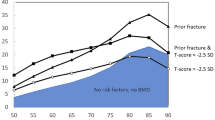Abstract
Introduction
Sarcopenia is a key predictor of prognosis in patients with hip fractures. This study utilized computed tomography (CT) scan (1) to determine the association between psoas muscle cross-sectional area (CSA) and mortality, along with other muscles, and (2) to confirm the correlation between muscle CSA and appendicular lean mass (ALM) measured using DXA in elderly patients with hip fracture.
Materials and methods
Patients who were aged ≥ 50 years and underwent surgical treatment for hip fracture were eligible for this study. After a series of exclusion criteria, 217 female patients were included. Patient data, including clinical characteristics, such as body mass index (BMI), CSA, and ALM, were retrospectively collected. The Kaplan–Meier survival method and Cox proportional hazards regression analysis were used for the statistical analyses. The correlation between CSA/BMI and ALM was also assessed.
Results
Patients in the lowest quartile of psoas muscle CSA/BMI had shorter survival times than those in the other quartiles. When the Cox proportional hazards regression analysis was adjusted for multiple variables, the lowest quartile of the CSA/BMI of the psoas was a risk factor for mortality. The CSA/BMI of the psoas showed the highest correlation coefficient. The CSA/BMI ratio of the other muscles showed a moderately positive correlation with ALM.
Conclusion
The CSA of the psoas is associated with prognosis in elderly patients with hip fractures and shows a moderately positive correlation with ALM. Hence, the CSA of psoas is useful for predicting survival and muscle mass in elderly patients with hip fractures.


Similar content being viewed by others
References
Chen Y-P, Wong P-K, Tsai M-J, Chang W-C, Hsieh T-S et al (2020) The high prevalence of sarcopenia and its associated outcomes following hip surgery in Taiwanese geriatric patients with a hip fracture. J Formos Med Assoc 119:1807–1816
Ji H-M, Han J, Jin DS, Suh H, Chung Y-S, Won Y-Y (2016) Sarcopenia and sarcopenic obesity in patients undergoing orthopedic surgery. Clin Orhop Surg 8:194–202
Landi F, Calvani R, Ortolani E, Salini S, Martone AM et al (2017) The association between sarcopenia and functional outcomes among older patients with hip fracture undergoing in-hospital rehabilitation. Osteoporos Int 28:1569–1576
Yoo J-I, Kim H, Ha Y-C, Kwon H-B, Koo K-H (2018) Osteosarcopenia in patients with hip fracture is related with high mortality. J Korean Med Sci. https://doi.org/10.3346/jkms.2018.33.e27
Cesari M, Fielding RA, Pahor M, Goodpaster B, Hellerstein M et al (2012) Biomarkers of sarcopenia in clinical trials-recommendations from the International Working Group on Sarcopenia. J Cachexia Sarcopenia Muscle 3:181–190
Moon SW, Lee SH, Woo A, Leem AY, Lee SH, Chung KS, Kim EY, Jung JY, Kang YA, Park MS, Kim YS, Kim CO, Kim SY (2022) Reference values of skeletal muscle area for diagnosis of sarcopenia using chest computed tomography in Asian general population. J Cachexia Sarcopenia Muscle 13:955–965
Byun S-E, Kim S, Kim K-H, Ha Y-C (2019) Psoas cross-sectional area as a predictor of mortality and a diagnostic tool for sarcopenia in hip fracture patients. J Bone Miner Metab 37:871–879
Englesbe MJ, Patel SP, He K, Lynch RJ, Schaubel DE et al (2010) Sarcopenia and mortality after liver transplantation. J Am Coll Surg 211:271–278
Hervochon R, Bobbio A, Guinet C, Mansuet-Lupo A, Rabbat A et al (2017) Body mass index and total psoas area affect outcomes in patients undergoing pneumonectomy for cancer. Ann Thorac Surg 103:287–295
Prado CM, Lieffers JR, McCargar LJ, Reiman T, Sawyer MB et al (2008) Prevalence and clinical implications of sarcopenic obesity in patients with solid tumours of the respiratory and gastrointestinal tracts: a population-based study. Lancet Oncol 9:629–635
Rutten IJ, Ubachs J, Kruitwagen RF, Beets-Tan RG, Olde Damink SW, Van Gorp T (2017) Psoas muscle area is not representative of total skeletal muscle area in the assessment of sarcopenia in ovarian cancer. J Cachexia Sarcopenia Muscle 8:630–8
Ebadi M, Wang CW, Lai JC, Dasarathy S, Kappus MR et al (2018) Poor performance of psoas muscle index for identification of patients with higher waitlist mortality risk in cirrhosis. J Cachexia Sarcopenia Muscle 9:1053–1062
Durand F, Buyse S, Francoz C, Laouénan C, Bruno O et al (2014) Prognostic value of muscle atrophy in cirrhosis using psoas muscle thickness on computed tomography. J Hepatol 60:1151–1157
Sim J-H, Lee S-H, Kim J-W, Koh W-U, Kim H-T et al (2021) Low psoas lumbar vertebral index is associated with mortality after hip fracture surgery in elderly patients: A retrospective analysis. J Pers Med 11:673
Looijaard SM, Maier AB, Voskuilen AF, Van Zanten T, Bouman DE et al (2020) Are computed tomography-based measures of specific abdominal muscle groups predictive of adverse outcomes in older cancer patients? Heliyon 6:e05437
Studenski SA, Peters KW, Alley DE, Cawthon PM, McLean RR et al (2014) The FNIH sarcopenia project: rationale, study description, conference recommendations, and final estimates. J Gerontol A Biol Sci Med Sci 69:547–558
Tang T-C, Hwang A-C, Liu L-K, Lee W-J, Chen L-Y et al (2018) FNIH-defined sarcopenia predicts adverse outcomes among community-dwelling older people in Taiwan: results from I-Lan longitudinal aging study. J Gerontol A Biol Sci Med Sci 73:828–834
Acknowledgements
This work was supported by the National Research Foundation of Korea grant funded by the Korean government (MSIT) (Nos. 2022R1A2C2005916 and 2022R1A2C2005887).
Author information
Authors and Affiliations
Contributions
Project administration, data curation, formal analysis, and writing—original draft: S-EB; Data curation, formal analysis, and writing—original draft: J-WK; Data curation and formal analysis: JK; and Conceptualization, funding acquisition, investigation, methodology, and manuscript review and editing: SL.
Corresponding author
Ethics declarations
Conflict of interest
The authors have no conflicts of interest to declare.
Additional information
Publisher's Note
Springer Nature remains neutral with regard to jurisdictional claims in published maps and institutional affiliations.
Supplementary Information
Below is the link to the electronic supplementary material.
About this article
Cite this article
Byun, SE., Kim, JW., Koo, J. et al. Psoas muscle area is associated with prognosis in elderly patients with hip fracture. J Bone Miner Metab 42, 115–121 (2024). https://doi.org/10.1007/s00774-023-01485-0
Received:
Accepted:
Published:
Issue Date:
DOI: https://doi.org/10.1007/s00774-023-01485-0




